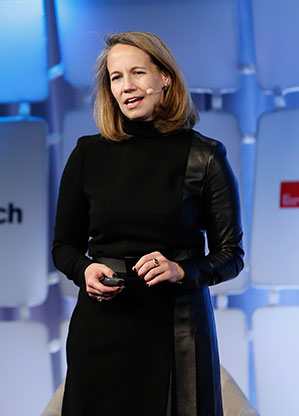CRISPR Gene Editing to Be Tested on People by 2017, Says Editas
The biotechnology startup Editas Medicine intends to begin tests of a powerful new form of gene repair in humans within two years.

Speaking this week at the EmTech conference in Cambridge, Massachusetts, Editas CEO Katrine Bosley said the company hopes to start a clinical trial in 2017 to treat a rare form of blindness using CRISPR, a groundbreaking gene-editing technology.
If Editas’s plans move forward, the study would likely be the first to use CRISPR to edit the DNA of a person.
CRISPR technology was invented just three years ago but is so precise and cheap to use it has quickly spread through biology laboratories. Already, scientists have used it to generate genetically engineered monkeys, and the technique has stirred debate over whether modified humans are next (see “Engineering the Perfect Baby”).
Editas is one of several startups, including Intellia Therapeutics and CRISPR Therapeutics, that have plans to use the technique to correct DNA disorders that affect children and adults. Bosley said that because CRISPR can “repair broken genes” it holds promise for treating several thousand inherited disorders caused by gene mistakes, most of which, like Huntington’s disease and cystic fibrosis, have no cure.
Editas, which had not previously given a timeline for an initial human test of CRISPR, will try to treat one form of a rare eye disease called Leber congenital amaurosis, which affects the light-receiving cells of the retina.
The condition Editas is targeting affects only about 600 people in the U.S., says Jean Bennet, director of advanced retinal and ocular therapeutics at the University of Pennsylvania’s medical school. “The target that they have selected is fantastic; it has all the right characteristics in terms of making a correction easily,” says Bennett, who isn’t involved in the Editas study.
Children with LCA are born seeing only large, bright shapes, and infants are diagnosed when they don’t look into their mother’s eyes or react to colorful balloons. Their poor vision can progress to “stone cold blindness where everything is black,” says Bennett.
Editas picked the disease in part because it is relatively easy to address with CRISPR, Bosley said. The exact gene error is known, and the eye is easy to reach with genetic treatments. “It feels fast, but we are going at the pace science allows,” she said. There are still questions about how well gene-editing will work in the retina and whether side effects could be caused by unintentional changes to DNA.
Editas plans to deliver the CRISPR technology as a gene therapy. The treatment will involve injecting into the retina a soup of viruses loaded with the DNA instructions needed to manufacture the components of CRISPR, including a protein that can cut a gene at a precise location. Bosley said in order to treat LCA, the company intends to delete about 1,000 DNA letters from a gene called CEP290 in a patient’s photoreceptor cells.
After the edit, preliminary lab experiments show, the gene should function correctly again. Bosley said Editas still needs to test the approach further in the lab and in animals before a human study starts.
Editas was created by venture capital funds including Third Rock Ventures in 2013 and was cofounded by scientists including Feng Zhang of the MIT/Harvard Broad Institute. It has raised more than $160 million in capital, allowing it to pursue ideas for several treatments simultaneously, Bosley said.
Although the Editas study could be the first for CRISPR in humans, it wouldn’t be the first clinical study of gene editing. An older method called zinc fingers is already in testing to treat HIV infection by the biotechnology company Sangamo Biosciences. But the versatility and ease with which CRISPR can change DNA means it may outpace earlier approaches.
Theoretically, gene editing could be used to repair broken genes in any part of the body. But in practice it is difficult to make DNA repairs in most cell types, such as brain cells. The eye is an exception because doctors can inject treatment directly under the retina.
There is already a gene-therapy treatment for one form of LCA in late-stage clinical testing by Philadelphia biotech Spark Therapeutics, says Bennett, who helped develop that treatment. In that case, an entire, healthy version of a gene is being added to eye cells. Typically, gene therapy can only add genes, not edit them.
LCA has several different genetic causes, and standard gene therapy won’t work for the form of the disease Editas is looking at. That is because the required gene, CEP290, is too big to fit inside a virus, says Bennett, and so there is no easy way to add it.
By targeting an exceptionally rare illness, Editas may have an easier time getting a treatment tested and approved. However, the eventual cost of such a treatment could be extraordinarily high, given the small number of people who would need it. Bennett says only around 3,000 Americans have LCA, and about 20 percent of those have the form being targeted by Editas.
Keep Reading
Most Popular
Large language models can do jaw-dropping things. But nobody knows exactly why.
And that's a problem. Figuring it out is one of the biggest scientific puzzles of our time and a crucial step towards controlling more powerful future models.
The problem with plug-in hybrids? Their drivers.
Plug-in hybrids are often sold as a transition to EVs, but new data from Europe shows we’re still underestimating the emissions they produce.
Google DeepMind’s new generative model makes Super Mario–like games from scratch
Genie learns how to control games by watching hours and hours of video. It could help train next-gen robots too.
How scientists traced a mysterious covid case back to six toilets
When wastewater surveillance turns into a hunt for a single infected individual, the ethics get tricky.
Stay connected
Get the latest updates from
MIT Technology Review
Discover special offers, top stories, upcoming events, and more.